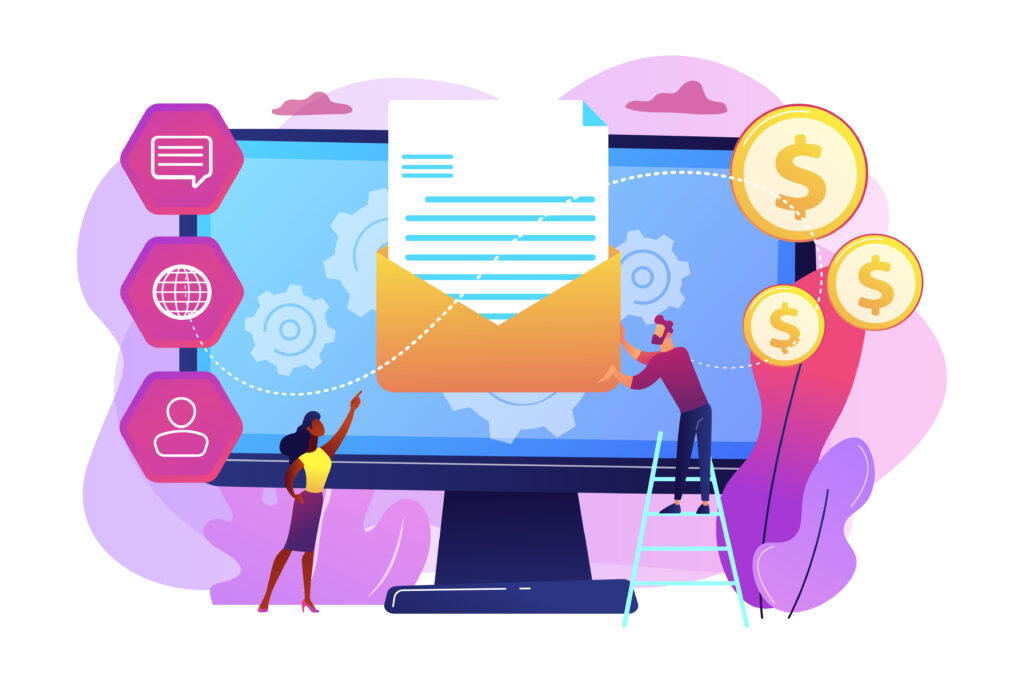
Key Takeaways
- eCommerce email campaigns are vital for driving conversions and business success.
- Successful campaigns require careful planning, strategy, and execution.
- Employing email marketing techniques helps businesses connect, nurture, and convert their audience.
- Effective eCommerce email campaigns involve sending persuasive messages, building relationships, and exciting customers.
- Key strategies include defining goals and target audience, building quality email lists, crafting compelling content, segmenting, automating workflows & many more.
In the fast-paced world of eCommerce, email campaigns play a crucial role in driving conversions and maximizing the success of businesses.
Crafting effective eCommerce email campaigns is an art that requires careful planning, strategy, and execution.
By employing the proper techniques and leveraging the power of email marketing, businesses can connect with their audience, nurture relationships, and ultimately achieve their conversion goals.
In this guide, we will walk you through the process of creating effective email campaigns in eCommerce and the strategies involved in creating impactful eCommerce email campaigns that engage customers and convert them into loyal buyers.
- What do you mean by an eCommerce email campaigns?
- Strategies of eCommerce email campaigns
- 1. Define your goals and target audience
- 2. Build a high-quality email list
- 3. Craft compelling subject lines
- 4. Create engaging email content
- 5. Segment your email list
- 6. Implement automated workflows
- 7. Test & optimize your campaigns
- 8. Monitor & measure results
- 9. Maintain mail deliverability and compliance
What do you mean by an eCommerce email campaigns?

An eCommerce email campaign is like conversing with your customers through email to promote your online store and products.
It’s a way to reach out to people interested in what you offer and persuade them to make a purchase.
You send a series of carefully crafted emails at the right time to grab their attention, offer special deals, remind them about items left in their shopping cart, and follow up after they’ve made a purchase.
It’s all about building relationships with your customers and keeping them excited about your brand.
So, think of it as sending friendly and persuasive messages directly to their inbox to make them want to shop with you repeatedly!
Strategies of eCommerce email campaigns

1. Define your goals and target audience
Clearly define your email campaign goals: Consider what you want to achieve, such as selling more products, getting more people to visit your website, or letting customers know about new offerings.
Identify your target audience: Understand who your customers are, what they like, and what they need. This will help you create campaigns that resonate with them and grab their attention.
2. Build a high-quality email list
Optimize your website for lead generation: Make it easy for visitors to subscribe to your emails by placing sign-up forms strategically.
Offer incentives like exclusive discounts or valuable content to encourage sign-ups.
Leverage social media and marketing channels: Use platforms like Facebook, Instagram, and blogs to capture email addresses.
You can also use appealing call-to-action buttons and dedicated landing pages to entice people to join your email list.
Ensure compliance with regulations: Make sure you’re following the rules when it comes to data protection.
Get proper consent from subscribers, provide clear options to unsubscribe, and respect their privacy.
3. Craft compelling subject lines
Grab attention with intriguing language: Use subject lines that spark curiosity and make people want to know more. For example, “Don’t miss out on our exclusive deals!”
Personalize: Make your subscribers feel special by addressing them by their names or including personalized recommendations based on their interests or previous purchases.
Keep it concise & avoid spam triggers: Keep your subject lines short and sweet. Avoid using too many capital letters or words that might trigger spam filters.
4. Create engaging email content
Design visually appealing emails: Make sure your emails look good and reflect your brand. Use colors, fonts, and visually appealing images consistent with your overall style.
Write persuasive and clear copy: Use simple language to communicate your message and explain the benefits of your products or services. Make it easy for readers to understand what you’re offering and why they should care.
Use captivating visuals: Include eye-catching product images or graphics to grab attention and make your emails more visually appealing.
Include clear calls-to-action (CTAs): Guide your subscribers toward the action you want them to take, whether it’s making a purchase, exploring more products, or signing up for an event.
Use buttons or links that stand out and make it easy for them to take the next step.
5. Segment your email list
Divide your subscribers into groups: Group your subscribers based on age, location, or past purchases. You can send them emails relevant to their specific needs and interests.
Customize your email content: Tailor your messages to each segment. For example, if you’re promoting a sale of women’s clothing, send that email specifically to your female subscribers.
Use behavior-based segmentation: Pay attention to how subscribers interact with your emails or website. Send different emails to those who have recently made a purchase, haven’t visited in a while, or have shown interest in specific products.
6. Implement automated workflows
Welcome emails: Automatically send a warm welcome to new subscribers. Thank them for joining and offer them a special discount or exclusive content to get them excited about your brand.
Abandoned cart reminders: If someone adds items to their cart but doesn’t complete the purchase, send them a friendly reminder with a special incentive to encourage them to come back and finish their purchase.
Let them know that their items are still waiting for them and offer a limited-time discount or free shipping to entice them to complete the transaction.
Post-purchase follow-ups: After a customer makes a purchase, send them a thank-you email expressing your gratitude. You can also use this opportunity to ask for their feedback or reviews on the product they purchased.
Additionally, recommend related products that they might be interested in based on their purchase history.
Re-engagement campaigns: Identify subscribers who have become less engaged with your emails. Send them targeted emails with personalized offers, such as exclusive discounts or a sneak peek of upcoming products, to rekindle their interest and bring them back to your brand.
7. Test & optimize your campaigns
A/B testing: Test different versions of your emails by making small changes to elements like subject lines, CTAs, or visuals.
Send each version to a portion of your audience and compare the results to see which one performs better.
This will help you learn what resonates with your subscribers and refine your campaigns accordingly.
Analyze key metrics: Keep an eye on important metrics like open rates (how many people open your emails), click-through rates (how many people click on your CTAs), and conversion rates (how many people complete the desired action, like making a purchase).
Analyzing these metrics will give you insights into the effectiveness of your campaigns and help you make data-driven decisions.
Gather user feedback: Encourage your subscribers to provide feedback on your emails through surveys or direct communication.
Ask them what they liked or didn’t like, what they would like to see more of, or any suggestions they may have.
This valuable feedback can guide you in improving your campaigns and providing a better experience for your audience.
8. Monitor & measure results
Utilize email analytics tools: Take advantage of email marketing platforms or third-party analytics tools to track and measure the performance of your campaigns.
These tools can provide detailed insights into metrics, segment performance, and subscriber behavior, helping you understand the impact of your email campaigns.
Set benchmarks and goals: Establish benchmarks based on industry standards or your previous campaign performance.
Set specific goals for your campaigns, such as increasing open rates by a certain percentage or achieving a higher conversion rate.
Regularly compare your results against these benchmarks and goals to gauge your success and identify areas for improvement.
Iterate and refine: Make data-driven decisions to refine your campaigns based on your analysis and insights.
Test new strategies, adjust your content or targeting, and track the impact of these changes on your key metrics.
Continuously optimize and experiment to improve the effectiveness of your email campaigns.
9. Maintain mail deliverability and compliance
Choose a reputable email service provider: Select a trusted email service provider that prioritizes deliverability and provides the necessary tools to maintain a good sender reputation.
This will ensure that your emails reach your subscribers’ inboxes and are not flagged as spam.
Optimize for deliverability: Avoid using spam trigger words or phrases in your subject lines or email content.
Regularly clean your email list by removing inactive or bounced email addresses. An email list cleaner can help you efficiently manage your email marketing campaigns by ensuring your list is up-to-date and free of invalid addresses.
Implement double opt-in to confirm subscribers’ intent and reduce the chances of sending emails to invalid or uninterested recipients.
Comply with regulations: Familiarize yourself with data protection regulations like GDPR or CAN-SPAM Act and ensure that your email campaigns adhere to these guidelines.
Obtain proper consent from subscribers, provide clear and easy-to-use unsubscribe options, and respect subscribers’ preferences regarding the frequency and type of emails they receive.
Conclusion
Creating effective eCommerce email campaigns is a game-changer for businesses seeking to thrive in the competitive digital landscape.
By harnessing the potential of email marketing, understanding the needs of your target audience, employing personalized and engaging content.
You can drive conversions and foster long-term customer loyalty.
With diligent testing, optimization, and monitoring of results, you can continuously improve the effectiveness of your campaigns and stay ahead of the curve.
Remember, email campaigns are not just about sending promotional messages; they are an opportunity to build meaningful connections with your customers and deliver value.
By following the strategies outlined in this guide, you can create email campaigns that convert and propel your eCommerce business to new heights of success.
